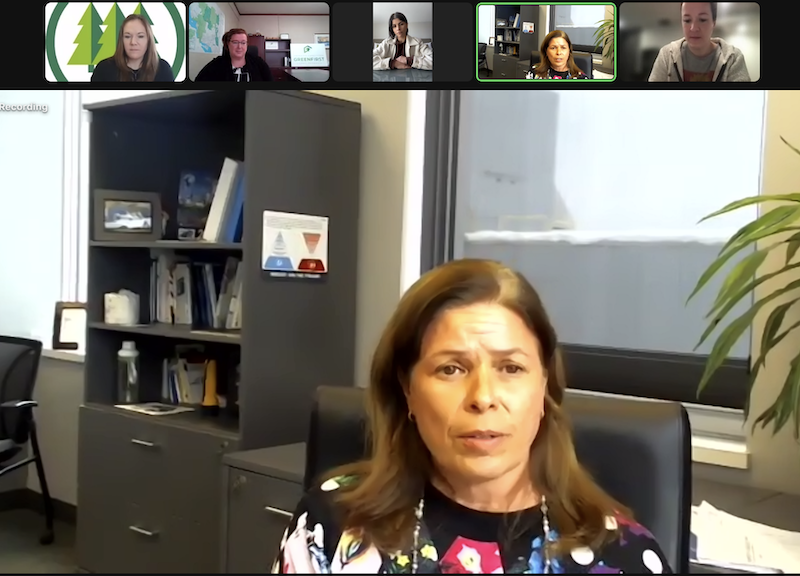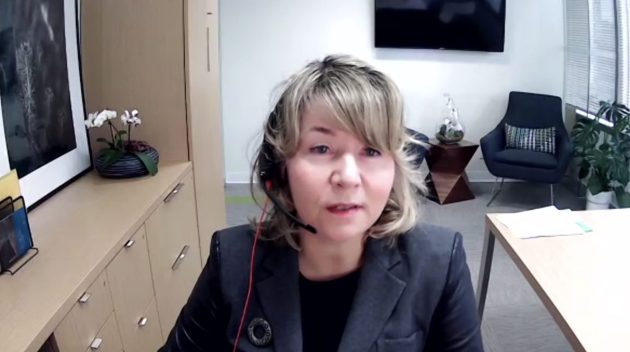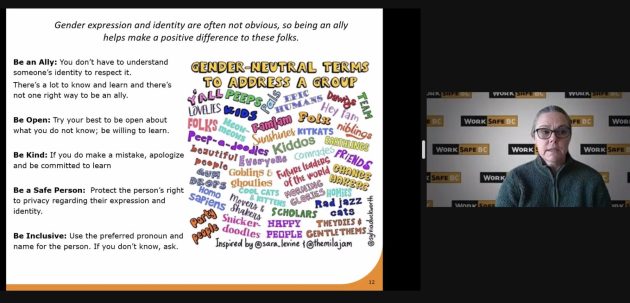
Breaking biases: Women in Forestry Virtual Summit tackles difficult questions
March 10, 2022
By
Maria Church
 Marie Cyr, general manager for Domtar Dryden. Top, from left: Haleigh Callison, lumber trader with Olympic Industries, Geneviève Labrecque, chief forester – Quebec, GreenFirst Forest Products, Ashley Sidhu, log truck driver, Malla Trucking, Sara Davies, ticketed circular sawfiler, Spray Lake Sawmills.
Marie Cyr, general manager for Domtar Dryden. Top, from left: Haleigh Callison, lumber trader with Olympic Industries, Geneviève Labrecque, chief forester – Quebec, GreenFirst Forest Products, Ashley Sidhu, log truck driver, Malla Trucking, Sara Davies, ticketed circular sawfiler, Spray Lake Sawmills. This year’s International Women’s Day theme was Break the Bias and it was perhaps the most fitting yet for our annual Women in Forestry Virtual Summit. Biases – whether they are held personally, by family, friends, work colleagues, or society in general – are keeping women and others with diverse backgrounds out of the forest industry.
It should go without saying now that the industry needs to diversify its workforce to address the critical labour shortage. Bluntly put: there are only so many white men. That’s not even factoring in the plethora of business advantages that come from having a diverse team.
To change that, we need to talk about it – openly and honestly.
The Women in Forestry summit, held virtually on March 8, drew more than 850 registrants with 550 joining us live to talk about biases, culture changes, career ladders, Indigenous inclusion and so much more. These are not conversations for women only – anyone with a stake in the future of the forest industry needs to be talking about these issues.
Below is a snapshot of what our incredible speakers shared during the summit, but we encourage you to watch the recorded sessions to get the full picture. (Register by emailing events@annexbusinessmedia.com.)
Executive ladder
Susan Yurkovich, outgoing president and CEO of the BC Council of Forest Industries (COFI), kicked off the summit with an inspiring reflection on her career in the forest industry and, specifically, the executive world. Yurkovich is the first woman at the reins of COFI and was often the only women at the boardroom table.
“I would never let them see me sweat,” Yurkovich said, explaining that life as both a mother and an executive was at times messy and difficult. “I learned quickly if you could help a mill manager fix his problem, he didn’t care what you looked like or how old you were.”
Yurkovich shared a list of observations on what made her successful:
- Have a plan but be flexible
- Take a calculated risk
- Do your homework – there is no substitute for that
- Find your people and stick with them
- Don’t be afraid to ask for help
- Life is not always a straight line
“Ours is a complex business. It requires a commitment of time. But once you understand it, your value will grow,” she said.
Indigenous inclusion
Innu woman and entrepreneur Mélanie Paul spoke next on what Indigenous inclusion in forestry looks like to her as the president of two Quebec forestry-adjacent companies, Inukshuk Synergie and Akua Nature.
Paul first shared her experience as an Indigenous woman working for her father’s group of companies, which includes wood pellet producer Granules LG – the largest pellet producer in Quebec. Paul said she has felt imposter syndrome and experienced racism, both in the mostly non-Indigenous, male-dominated forest industry and in her home Innu community.
But she rose to the challenge and has since launched her own companies, which place emphasis on Indigenous ownership and inclusion. Akua Nature is 51 per cent Indigenous-women owned.
Sharing advice on working with Indigenous groups, Paul said it’s important to take the time to establish meaningful relationships with community leaders and to understand their obstacles and barriers before offering solutions. That trust can then lead to memorandums of understanding, which are useful tools for both parties to trial an agreement before signing on a dotted line.
Embracing your change power
As society’s values change, workplace cultures must change to keep up. Forestry consultants Dana Collins and Cynthia Lu gave an interactive workshop-style presentation on how to grow a culture change, with a focus on the individual’s power.
Top-down approaches to change can fail if there is a lack of purpose in the workforce, Collins said. When it’s all boiled down, culture change lies in the habits and behaviours of individuals.
Lu and Collins took the audience through a systems mapping exercise that showed how an individual can identify their values and where they fit in the system to understand where they can help change that system.
Using a real-world example from Lu’s previous work experience, Collins and Lu went back and forth to analyze the situation and map out where Lu had leverage to make changes and predict how those small changes could help solve underlying issues.
“If we start to see challenges from a systems lens, we can see the complexities and start to see solutions,” Collins said.
Action to traction
Kelly Cooper, founder of the Centre for Social Intelligence, and Doug Reid, vice-president of the Canadian Institute of Forestry, shared the latest from Free to Grow in Forestry – the sector-wide initiative to promote an equitable workplace culture in the forest sector.
The initiative has moved into its second phase of implementation, which will see it transition from a national scope to a regional focus. “Think of it as the arms and legs of the pillars of Phase 1,” Cooper said. “All the seeds we planted in Phase 1 have now germinated and are starting to grow for what we are doing for Phase 2.”
While Phase 1 focused on building the evidence base, identifying gaps and core principles, and creating tools and resources, Phase 2 will see direct engagement with and training for forest sector leaders and employees on what an inclusive workplace looks like and how to achieve it.
Free to Grow in Forestry’s online training modules launched March 7; find them here.
“Four years ago, this was seen as an uphill battle, but today … the wind is at your back,” Cooper said. “Not only is it possible to have a diverse and inclusive workplace, but it is a smart business decision.”
Breaking down biases
Five incredible women stepped up to take part in our summit panel on women excelling in non-traditional forestry roles. Moderated by lumber trader Haleigh Callison, the panel included sawfiler Sara Davies, chief forester Geneviève Labrecque, mill manager Marie Cyr, and log truck driver Ashley Sidhu.
Rather than summarize their words (I won’t do them justice), here are the main questions posed to the panelists and we again encourage you to watch the recording to hear their honest replies.
- For those who wanted to have a family or to start a family, have you ever felt that doing so was held back by your career, and if so, how did you navigate those challenges, especially with remove jobs? Did you ever feel pressure to not?
- Did you ever back away from forestry because it is male dominated? Face sexism? What tools have you used or developed to overcome those barriers?
- Has a job placement or advancement ever been criticized as tokenism or a diversity hire? How did you or how would you respond?
- How do you promote diversity and inclusion into your daily roles and what are ways we can better recruit other women to your field of work?
- How can men be allies in creating a more welcoming environment?
- What advice do you wish you got when you started your forestry journey?
Language matters
Closing out an incredible day, WorkSafeBC occupational officers Caity Klaudt, Carole Savage and Cindy Fife shared an explainer on the spectrum of gender diversity and why small communication changes can make a difference on jobsites.
“We know that inclusive industries are safer industries,” Savage said.
Gender-based violence is often very difficult to talk about and even more difficult to report, Klaudt said. Understanding gender expression and identity, whether it’s obvious or not, can make a huge difference when it comes to making people comfortable speaking up.
Klaudt shared a personal story about one of her earlier site inspections with WorkSafeBC when she “put her foot in her mouth” while addressing a group. It happens, she said, but she apologized to the individual involved, and then used it as her own learning experience.
Using gender-inclusive language is a simple way to avoid making gender assumptions, Fife explained. That means avoiding words like ladies, gentlemen, ma’am, sir, girls, and guys, and instead using friends, folks, everyone, and all.
Watch online
Missed out on the event? The entire Women in Forestry Virtual Summit is available on-demand, including additional pre-recorded sessions from the Canadian Forest Service and the Sustainable Forestry Initiative.
All of the sessions are free to watch – just register by emailing events@annexbusinessmedia.com to receive a link to the content.
Thank you to our sponsors for their support of the Women in Forestry Virtual Summit, and for making this event possible: Canfor, the Alberta Forest Products Association, GreenFirst Forest Products, Interfor, West Fraser, Free to Grow in Forestry, John Deere, Tolko, Cascades, WorkSafeBC, Alberta-Pacific Forest Industries, Forests Ontario, Resolute Forest Products, the Sustainable Forestry Initiative, Waratah, Woodtone, and Mosaic Forest Management.
Have an idea for next year’s sessions? Contact me at mchurch@annexbusinessmedia.com.
Print this page

